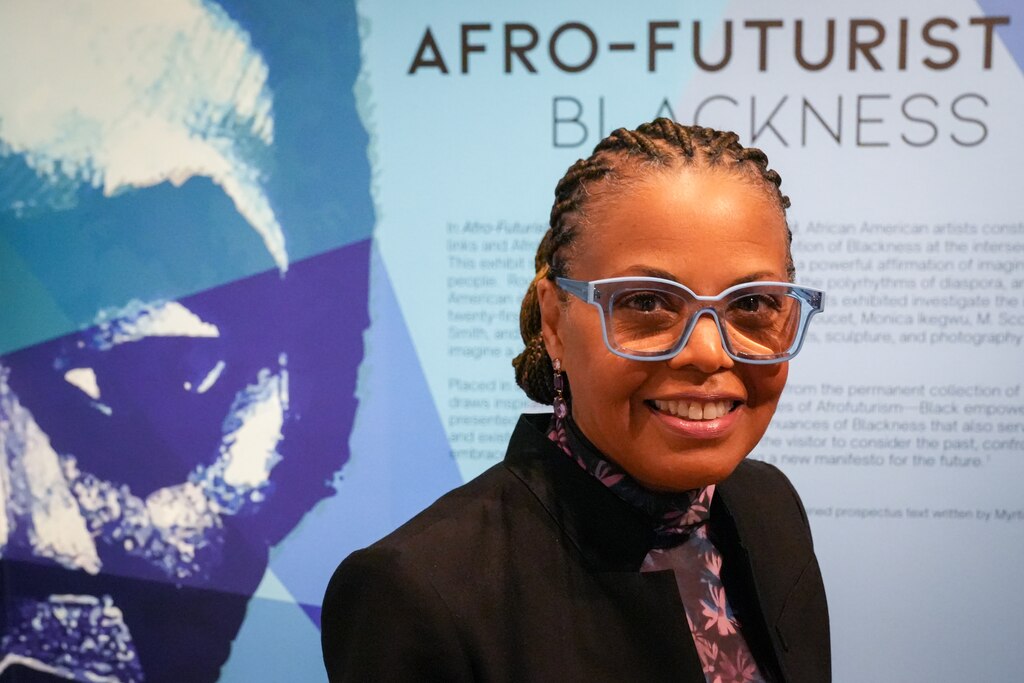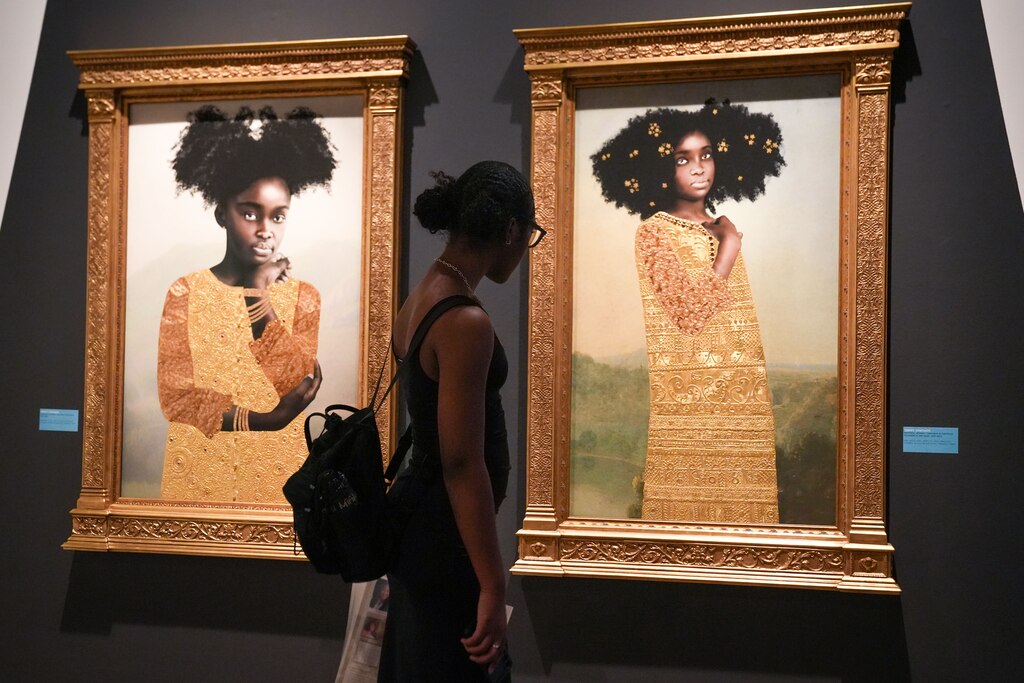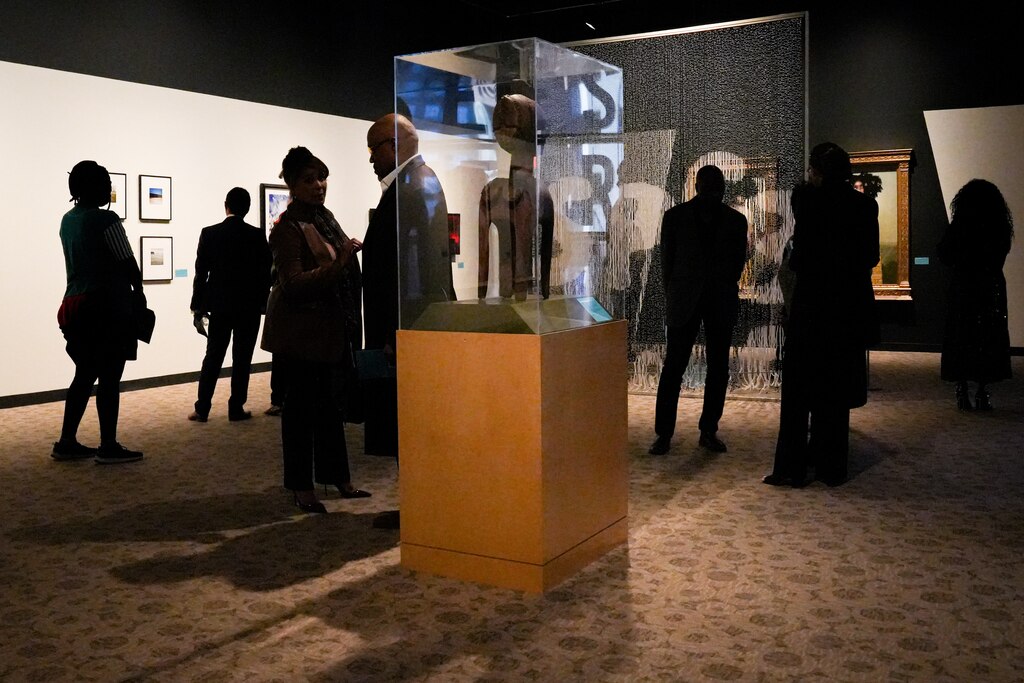Myrtis Bedolla was gobsmacked walking into the gallery. Her exhibition, “Afro-Futurist Manifesto: Blackness Reimagined,” was finally home in Baltimore.
The exhibition — now on display across the city at the Reginald F. Lewis Museum, the James E. Lewis Museum of Art and Galerie Myrtis — first showed at the Venice Biennale, a prestigious international art and cultural exhibition hosted each year in Italy. Bedolla was invited to participate after someone from the European Cultural Centre noticed her work at Art Basel in Miami, Florida.
“I was just so honored to be asked to participate in such an important cultural event,” Bedolla said. But the work was only beginning; she had to create a dynamic exhibition.
As gallerist at Galerie Myrtis, Bedolla supports and advises African American creators and their work from the 20th and 21st century. She represents several visionaries featured in her show, all of whom are “future-looking Black artists” — a term coined by leading Afrofuturist expert Reynaldo Anderson. The term refers to artists who are “challenging their [European/American] presumed authority to be the sole interpreters of Black lives and Black future,” Anderson said, according to a pamphlet for the exhibit.
The Baltimore Banner thanks its sponsors. Become one.

Before Bedolla featured the work in Venice, she turned her efforts to how she would eventually bring the works back to Charm City. One of her mentors, Leslie King-Hammond, serves on the board of the Reginald F. Lewis Museum and suggested it as one of the homes for the exhibition.
Bedolla and Terri Lee Freeman — the Reginald F. Lewis Museum’s executive director — spent a lot of time talking about the best ways to bring the pieces to life. The museum wanted to add works from its permanent collection of African art to exemplify how Afrofuturism looks back to African history to inform the future. The installation team at the museum sent digital renderings to model what the gallery would look like. Bedolla was thrilled with the final product. “The team at the Lewis museum has been so supportive,” she said.
The resulting “Afro-Futurist Manifesto” exhibit, now on display until September, features contemporary works that bring to light how expansive afrofuturism can be. Artist Felandus Thames made a sculpture from hair beads that hangs like a curtain and reads “Space is the Place,” a nod to afrofuturist Sun Ra’s 1974 album and movie of the same name.
A new team at the Jewish Museum of Maryland looks beyond history for inspiration
Hanging on the wall behind the curtain, artist Tawny Chatmon rendered two portraits of young Black girls. Each portrait is encased in custom gold frames featuring Black cherubs. “The gold frames evoke a sense of importance,” Chatmon said. The portraits are amalgamations of young Black girls with gold clothing and hair barrettes. Angelic Black girls may not seem futuristic, but reports show they are pushed out of schools and adultified at younger ages. Chatmon’s piece speaks to a future where people can see Black children and believe their innocence.

Portraiture continues throughout the exhibit. Baltimore native Monica Ikegwu makes portraits of her friends and family that put the subject in the driver’s seat. She gives her subjects agency by allowing them to choose their own pose and clothes. While there are lots of ways people try to define Black people for Black people, Ikegwu said, her practice lets the subjects define themselves. It is an issue that has been touched on many times before; Black feminist scholar Audre Lorde also spoke to the need to define oneself because otherwise she “would be crunched into other people’s fantasies.”
The Baltimore Banner thanks its sponsors. Become one.
“Afro-Futurist Manifesto” is a master class in self-definition. And though afrofuturism can be an intangible concept, curator Imani Haynes kept Bedolla’s collection in mind in her quest to make the topic more accessible for Lewis visitors.
“Imaginarium: A Social Imagination Experience,” on view until April 4, was inspired by the infographic work of scholar W.E.B. Du Bois, as well as librarian Thomas J. Calloway, who celebrated Black achievement at the World’s Fair in Paris in 1900. Haynes’ installation encourages visitors to answer questions about what their future may look like. They can use yarn and stickers to answer queries such as “Do you believe knowledge is power?” and “Where in the diaspora are you from?” The exhibit allows users to engage with the work while helping the Lewis Museum learn who is coming to their space and how they are interacting with it.
Though the “manifesto” has traveled far and wide, its home was always with Bedolla. “I knew I wanted it to be shown in Baltimore,” she said.




Comments
Welcome to The Banner's subscriber-only commenting community. Please review our community guidelines.